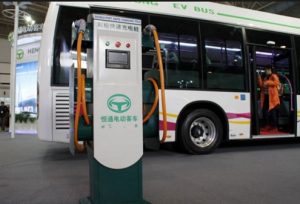 The Chinese government is taking punitive action on more than 25 vehicle manufacturers, from makers of passenger cars to buses, in a breaking scandal over subsidies granted for “new energy vehicles.” It’s one in a series of global scandals in the past year over false claims made by automakers related to regulatory compliance and subsidies for fuel economy, greenhouse gas emissions, and vehicle electrification.
The Chinese government is taking punitive action on more than 25 vehicle manufacturers, from makers of passenger cars to buses, in a breaking scandal over subsidies granted for “new energy vehicles.” It’s one in a series of global scandals in the past year over false claims made by automakers related to regulatory compliance and subsidies for fuel economy, greenhouse gas emissions, and vehicle electrification.
Five Chinese bus makers are being penalized by the government for taking about 1 billion yuan ($150 million) in illegal subsidies, including a division of popular Chinese carmaker Chery Holding. Nissan, Hyundai, Geely, Anhui Jianghuai Automobile (JAC Motor), a subsidiary of BYD, and other carmakers in China have been accused of violating funding program rules. One busmaker will have its production license revoked while other companies will be fined. Government incentives helped Chinese sales of all-electric and plug-in hybrid passenger vehicles, trucks, and buses climb to 331,000 units last year. The China Association of Automobile Manufacturers revised its estimate for this year’s new energy vehicle orders to 400,000 from 700,000 vehicles on Friday, after the government announcements on automakers being penalized.
On September 18, it will be one year since the Volkswagen diesel car emissions scandal blew up. On that day the U.S. Environmental Protection Agency issued a notice of violation of the Clean Air Act after finding VW intentionally programmed turbocharged direct injection (TDI) diesel engines to activate certain emissions controls only during laboratory emissions testing. Last week, a VW engineer became the first employee to be indicted and to plead guilty on criminal charges over the emissions cheating.
VW engineer James Robert Liang pleaded guilty to a single charge of conspiracy to commit fraud against the U.S. government and VW customers, and for violating the Clean Air Act. The plea agreement also includes Liang being willing to cooperate with the U.S. government’s investigation into the diesel emissions fraud investigation.
The conspiracy charge does indicate that other VW employees will face criminal charges by the U.S. government. This will take place during a vehicle recall process with government agencies in the U.S., Germany, South Korea, with other governments likely to follow a similar path.
Other automakers face intense government scrutiny in regulatory compliance. Fiat Chrysler Automobiles is under investigation in Germany for false reporting on diesel emissions. Mitsubishi had its corporate offices raided by law enforcement in Japan last month over its mileage reporting scandal; that follows similar reporting scandals that enmeshed Hyundai, Kia, and Ford in 2013-2014.
Here are a few questions I’d like to have answered by automakers over these scandals:
- Will uniform global standards be adopted by government agencies and automakers measuring vehicle mileage and greenhouse gas emissions? Automakers are measuring miles per gallon differently than the EPA, though that may be changing toward more uniformity. The speed cars are driven at, the weight of the vehicle, external temperatures and conditions, and road incline grades, affect mileage, automakers say. But can they follow uniform guidelines that determine how all vehicle mileage ratings are determined? Diesel emissions measures can be manipulated by the testing methods being utilized. Electric car driving range on a single charge illustrates the distinctions in reporting standards that can throw off measurements. An all-electric car may get 300 miles of range by European NEDC estimates, but it would be a shorter range by EPA standards. The automaker will brag about 300-mile range, but won’t explain the distinctions unless it’s in small type in a footnote.
- How serious are automakers about reducing emissions? Global automakers are fearing their demise in a fast-changing industry. The Chinese auto market is becoming the most important one beyond the U.S. and Europe; and other markets like India, Brazil and Russia are growing. Growing vehicle classes are changing the game, from SUVs, crossovers, and luxury vehicles. New technologies like autonomous systems, infotainment connectivity, mobility services, and collision-avoidance systems are up there with vehicle electrification, and many times are much more important to automakers. What’s going to motivate them to invest in electrified and alternative fuel vehicles – and that includes manufacturing and marketing through dealer networks?
- Will they get away with it? VW is going to spend at least $20 billon in the U.S. alone in the government settlements and court cases. VW and many players in the game seem to think the German automaker will eventually absorb these losses and clean up its act. Some automakers won’t be able to make it through this type of crisis unless they merge with larger companies (like Mitsubishi is doing with Nissan). Automakers would to be wise to take honest emissions reporting, and spending of public subsidies, much more seriously. Consumer surveys, purchase trends, voting patterns, and opinions shared over the internet, indicate that more is being expected from automakers – from transparency and authenticity, adoption of advanced vehicles technologies, sustainable manufacturing, and compliance with emissions standards.
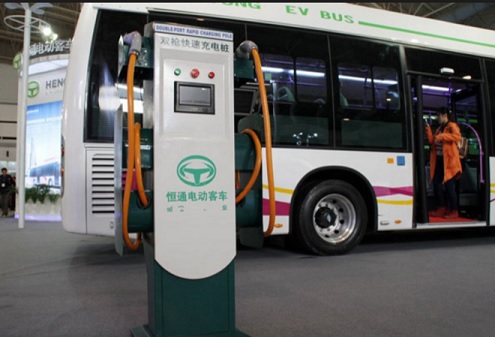 technology, announced in a speech Saturday that regulators are working on a timeline for phasing out the sales and production of the gasoline- and diesel-powered vehicles. Norway, France, and the UK, are already going in that direction. Almost 80 percent of the global auto market is heading toward an eventual phase-out of petroleum-powered cars through government incentives and mandates. It’s a big job – with about 695,000 of 84 million new vehicles sold last year being electric; and with about a billon vehicles out on roads across the world now.
technology, announced in a speech Saturday that regulators are working on a timeline for phasing out the sales and production of the gasoline- and diesel-powered vehicles. Norway, France, and the UK, are already going in that direction. Almost 80 percent of the global auto market is heading toward an eventual phase-out of petroleum-powered cars through government incentives and mandates. It’s a big job – with about 695,000 of 84 million new vehicles sold last year being electric; and with about a billon vehicles out on roads across the world now.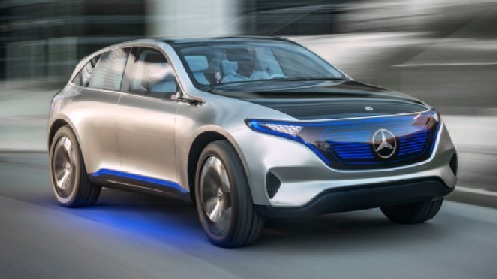 Cars, only expect to see half the profit margins now for EV compared to conventional internal combustion engine vehicles. That could break even, and EVs more price competitive, by 2025. Seeing battery prices come down will be a big part of it. More specifics were given on its electric fleet introductions – by 2022, there will be an electric version of every Mercedes model sold. It will be led by the new EQ electric brand, which Mercedes-Benz is overseeing. The Smart brand will stop selling vehicles with any internal combustion engines in 2020.
Cars, only expect to see half the profit margins now for EV compared to conventional internal combustion engine vehicles. That could break even, and EVs more price competitive, by 2025. Seeing battery prices come down will be a big part of it. More specifics were given on its electric fleet introductions – by 2022, there will be an electric version of every Mercedes model sold. It will be led by the new EQ electric brand, which Mercedes-Benz is overseeing. The Smart brand will stop selling vehicles with any internal combustion engines in 2020.
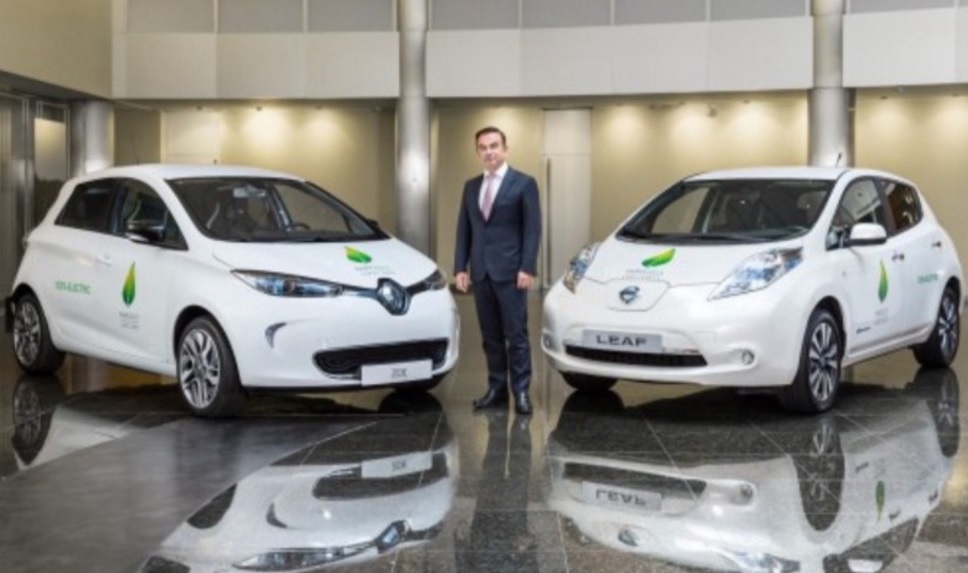 by 2019 through eGT New Energy Automotive Co., Ltd., the new company. The three companies have been in alliance for years with a shared factory already in place. It will tie into CEO Carlos Ghohn strategy to maximize economies of scale and become more EV competitive, along with Donfeng’s mission to bring “light, electric, intelligent, interconnected and shared” vehicles to the new energy vehicle market. China is in the process of becoming stricter on subsidies and watching out for another cheating scandal. The government is expected to soon announce a zero emission vehicle mandate similar to California’s. Whatever the government requires, automakers are not backing off China’s booming EV market.
by 2019 through eGT New Energy Automotive Co., Ltd., the new company. The three companies have been in alliance for years with a shared factory already in place. It will tie into CEO Carlos Ghohn strategy to maximize economies of scale and become more EV competitive, along with Donfeng’s mission to bring “light, electric, intelligent, interconnected and shared” vehicles to the new energy vehicle market. China is in the process of becoming stricter on subsidies and watching out for another cheating scandal. The government is expected to soon announce a zero emission vehicle mandate similar to California’s. Whatever the government requires, automakers are not backing off China’s booming EV market.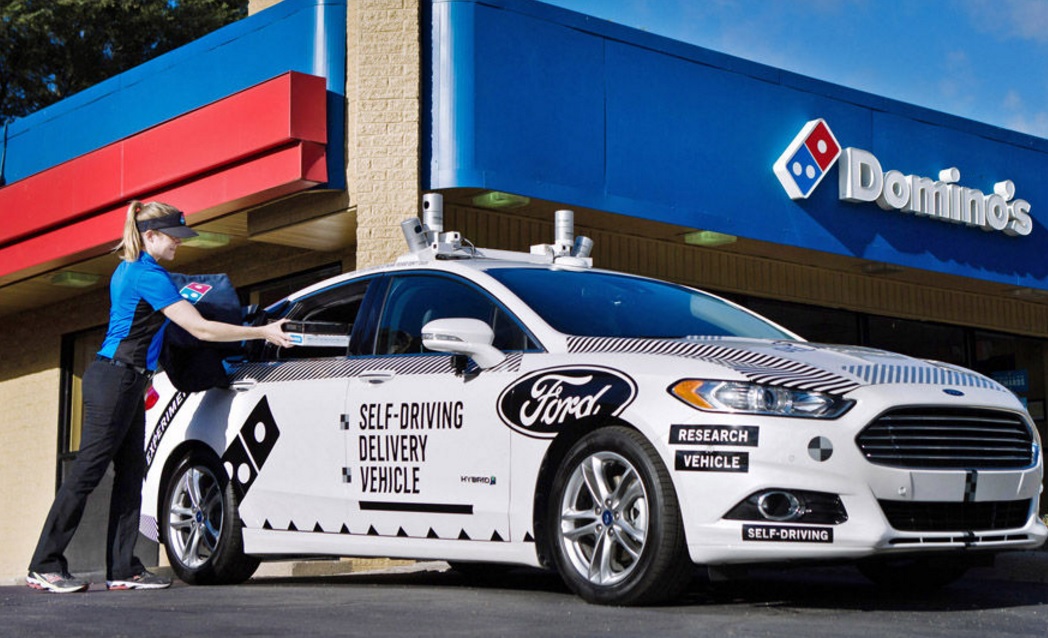 a pizza through a self-driving vehicle. Over the next few weeks, customers in Ann Arbor, Mich., will have the opportunity to receive their order from a Ford Fusion Hybrid Autonomous Research Vehicle. It will be manually-driven by a Ford safety engineer and staffed with researchers. Ford plans to begin producing self-driving vehicles in 2021 and will tap into the data from this test project.
a pizza through a self-driving vehicle. Over the next few weeks, customers in Ann Arbor, Mich., will have the opportunity to receive their order from a Ford Fusion Hybrid Autonomous Research Vehicle. It will be manually-driven by a Ford safety engineer and staffed with researchers. Ford plans to begin producing self-driving vehicles in 2021 and will tap into the data from this test project.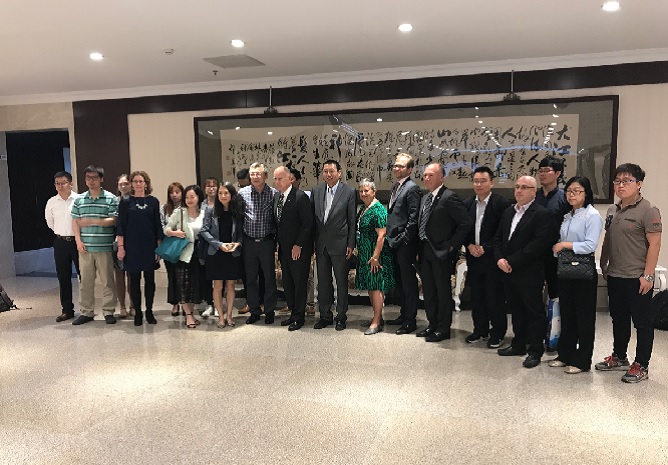 away from the Paris climate change accord. Governor Jerry Brown and California Air Resources Board chair Mary Nichols met with officials from China’s leading automakers and battery manufacturers this week in an effort to expand cooperation and accelerate deployment of zero-emission cars, trucks, and buses. A new working group was formed through the China-US ZEV Policy Lab at UC Davis to expand cooperation with Chinese vehicle and batter makers. The lab comes from a partnership established in 2014 between UC Davis Institute of Transportation Studies and the China Automotive Technology and Research Center. Brown and Nichols have been touring China this week as the nation prepares to adopt the state’s ZEV policy with credits for automakers to purchase and trade for meeting emissions rules.
away from the Paris climate change accord. Governor Jerry Brown and California Air Resources Board chair Mary Nichols met with officials from China’s leading automakers and battery manufacturers this week in an effort to expand cooperation and accelerate deployment of zero-emission cars, trucks, and buses. A new working group was formed through the China-US ZEV Policy Lab at UC Davis to expand cooperation with Chinese vehicle and batter makers. The lab comes from a partnership established in 2014 between UC Davis Institute of Transportation Studies and the China Automotive Technology and Research Center. Brown and Nichols have been touring China this week as the nation prepares to adopt the state’s ZEV policy with credits for automakers to purchase and trade for meeting emissions rules. certified to the optional low nitrogen oxide (NOx) level .05 g/bhp-hr. These new U.S. Environmental Protection Agency- and California Air Resources Board-certified propane engines are 75% cleaner than the current emissions standard. “Roush CleanTech’s low NOx engine is a great step forward for the propane industry,” said Tucker Perkins, president of the Propane Education & Research Council. “Propane autogas is well established as an economical, clean-burning and domestically produced alternative fuel ideal for fleets. Now propane gets the biggest return on NOx reductions, too.”
certified to the optional low nitrogen oxide (NOx) level .05 g/bhp-hr. These new U.S. Environmental Protection Agency- and California Air Resources Board-certified propane engines are 75% cleaner than the current emissions standard. “Roush CleanTech’s low NOx engine is a great step forward for the propane industry,” said Tucker Perkins, president of the Propane Education & Research Council. “Propane autogas is well established as an economical, clean-burning and domestically produced alternative fuel ideal for fleets. Now propane gets the biggest return on NOx reductions, too.”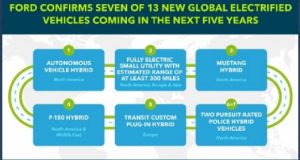 3 new global electrified vehicles the automaker plans to introduce in the next five years, including hybrid versions of the F-150 pickup and Mustang in the U.S., and a plug-in hybrid Transit Custom van in Europe. A high-volume autonomous hybrid vehicle designed for commercial ride hailing or ride sharing will be launched globally in 2021, starting in North America. Ford will also launch two new, pursuit-rated hybrid police vehicles. The automaker will be adding 700 direct new U.S. jobs and investing $700 million during the next four years, creating the new Manufacturing Innovation Center at its Flat Rock Assembly Plant in Michigan.
3 new global electrified vehicles the automaker plans to introduce in the next five years, including hybrid versions of the F-150 pickup and Mustang in the U.S., and a plug-in hybrid Transit Custom van in Europe. A high-volume autonomous hybrid vehicle designed for commercial ride hailing or ride sharing will be launched globally in 2021, starting in North America. Ford will also launch two new, pursuit-rated hybrid police vehicles. The automaker will be adding 700 direct new U.S. jobs and investing $700 million during the next four years, creating the new Manufacturing Innovation Center at its Flat Rock Assembly Plant in Michigan. The Chinese government is taking punitive action on more than 25 vehicle manufacturers, from makers of passenger cars to buses, in a breaking scandal over subsidies granted for “new energy vehicles.” It’s one in a series of global scandals in the past year over false claims made by automakers related to regulatory compliance and subsidies for fuel economy, greenhouse gas emissions, and vehicle electrification.
The Chinese government is taking punitive action on more than 25 vehicle manufacturers, from makers of passenger cars to buses, in a breaking scandal over subsidies granted for “new energy vehicles.” It’s one in a series of global scandals in the past year over false claims made by automakers related to regulatory compliance and subsidies for fuel economy, greenhouse gas emissions, and vehicle electrification.